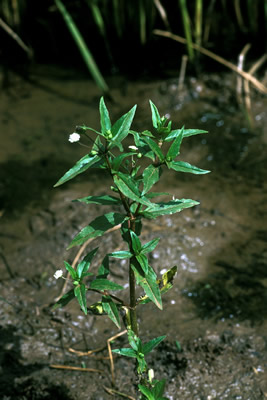Eclipta prostrata

Latin name
Eclipta prostrata (L.) L.
Family
Asteraceae
Common name
False daisy
Synonyms
Eclipta alba (L.) Hassk. (accepted), E. erecta L., Verbesina alba L., V. prostrata L., Wedelia psammophila Poepp.
Geographical distribution
Asia: China (including Taiwan), Japan, and Korea.
South and Southeast Asia: Bangladesh, India, Indonesia, Cambodia, Lao PDR, Malaysia, Nepal, Pakistan, Philippines, Sri Lanka, Thailand, and Vietnam.
Rest of the world: Angola, Arabian Peninsula, Argentina, Australia, Brazil, Colombia, Costa Rica, Cote d'Ivoire, Cuba, Egypt, Fiji, Ghana, Iraq, Mexico, Peru, Portugal, Puerto Rico, Rhodesia, Sudan, Surinam, Trinidad, United States of America (including Hawaii), Zambia, and Zimbabwe.
Morphology
A prostrate or reclining to erect, often branched, annual or perennial herb, 30−100 cm tall.
Stem: cylindrical, green or purplish, rooting at basal nodes, and often covered with long white hairs.
Leaf: oblong to lance-shaped, opposite, sessile or short-stalked, with more or less coarse hairs; margins entire or slightly toothed, up to 2−16 cm long.
Inflorescence: terminal and axillary, about 1 cm across, white or cream, on peduncles to 7 cm long.
Fruit: achene, densely warted, either brown or black, 2−3 mm long.
Biology and ecology
It is widespread and has adapted to a range of environments. It is found in poorly drained wet areas, saline conditions, along streams, in drains and canals of irrigated lowland rice paddies, in waste areas, and in upland fields.
A single plant can produce as many as 17,000 seeds; germination affected by light, moisture level, pH, and temperature, but seeds have no dormancy.
Agricultural importance
It is a common weed of rainfed lowland rice in the Philippines, Indonesia, and India, and other crops, including sugarcane, flax, taro, papaya, banana, soybean, vegetables, and cotton.
Eclipta prostrata is an alternate host of root-knot nematodes (Meloidogyne spp.).
Management
Cultural control: cultivation and hand weeding.
Chemical control: preemergence application of oxadiazon or postemergence spraying of either 2,4-D or MCPA reported to be effective.
Selected references
- Caton BP, Mortimer M, Hill JE. 2004. Weeds of rice in Asia. Los Baños (Philippines): International Rice Research Institute. 116 p.
- Galinato MI, Moody K, Piggin CM. 1999. Upland rice weeds of South and Southeast Asia. Manila (Philippines): International Rice Research Institute. 156 p.
- Holm L, Plucknett DL, Pancho JV, Herberger JP. 1977. The world's worst weeds: distribution and biology. Honolulu, Hawaii (USA): University Press of Hawaii. 609 p.
- Holm L, Pancho JV, Herberger JP, Plucknett DL. 1979. A geographical atlas of world weeds. New York (USA): John Wiley & Sons, Inc. 391 p.
- Li H. 1978. Compositae. Flora Taiwan. 4:768-965.
- Moody K. 1989. Weeds reported in South and Southeast Asia. Manila (Philippines): International Rice Research Institute. 442 p.
- Pancho JV, Obien SR. 1995. Manual of ricefield weeds in the Philippines. Muñoz, Nueva Ecija (Philippines): Philippine Rice Research Institute. 543 p.







